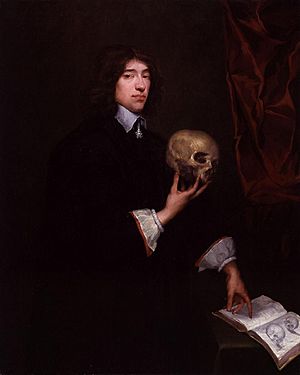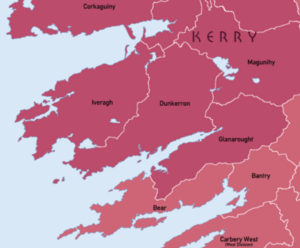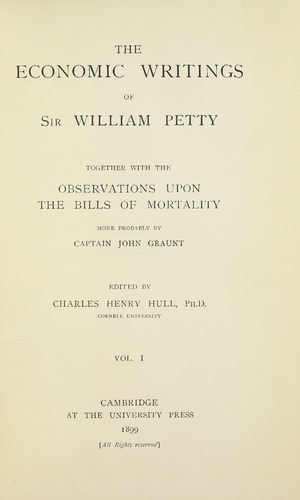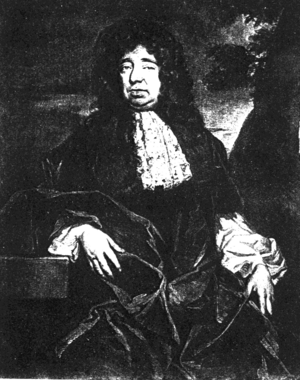William Petty facts for kids
Quick facts for kids
William Petty
|
|
|---|---|
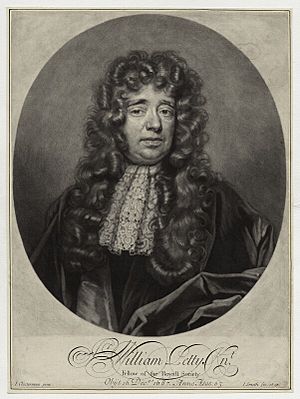
Sir William Petty, mezzotint by John Smith after John Closterman
|
|
| Born | 26 May 1623 |
| Died | 16 December 1687 London, England
|
| Era | 17th-century philosophy (Modern philosophy) |
| Region | Western philosophy |
| School | Classical economics |
|
Main interests
|
Political philosophy, ethics, economics, medicine |
|
Notable ideas
|
Division of labour, the growth of London, fiscal theory, monetary theory, national income accounting, economic statistics |
|
Influences
|
|
|
Influenced
|
|
Sir William Petty was an English thinker who lived from 1623 to 1687. He was an economist, doctor, scientist, and philosopher. He became well-known while working for Oliver Cromwell in Ireland. Petty created smart ways to survey land that was taken and given to Cromwell's soldiers. He remained important even after Cromwell, serving under King Charles II and King James II.
Petty was also an inventor and a merchant. He was one of the first members of the Royal Society, a famous group of scientists. He is best remembered for his ideas about economics and his special way of using numbers, called political arithmetic. People often say he started the idea of laissez-faire economics, which means less government control. He was made a knight in 1661.
Life Story
Early Years
William Petty was born in Romsey, England. His father and grandfather were cloth sellers. He was a very smart kid. In 1637, he became a cabin boy on a ship. But he broke his leg and was left in Normandy, France.
After this, he bravely asked to study with the Jesuits in Caen, France, using his Latin skills. He paid for his studies by teaching English. After a year, he returned to England. By then, he knew a lot about Latin, Greek, French, math, and astronomy.
After a short time in the Navy, Petty went to study in Holland in 1643. There, he became very interested in how the human body works. He became a personal helper to Thomas Hobbes, a famous philosopher. This allowed him to meet other great thinkers like René Descartes. In 1646, he came back to England. He tried to sell a special writing tool but didn't have much luck. So, he studied medicine at Oxford. He became friends with Robert Boyle, a famous scientist.
His Career
Teacher and Land Surveyor
By 1651, Petty was teaching anatomy at Brasenose College, Oxford. He was one of the doctors who treated Anne Greene. She was a woman who survived being hanged! People thought it was a miracle, which helped Petty's career. He also taught music in London.
In 1652, he went to Ireland with Oliver Cromwell's army as their main doctor. Petty didn't like traditional universities. He preferred a "new science" approach, inspired by Francis Bacon. He was ambitious and wanted wealth. This led him to Ireland. In 1654, he got a huge job: mapping all of Ireland. This was so Cromwell's soldiers, who had loaned money, could be paid back in land. He finished this massive task by 1656. It was called the Down Survey.
As a reward, he received about 30,000 acres (120 km2) of land in Kenmare, Ireland, and £9,000. This personal gain led to many legal problems for him, with people accusing him of bribery. These cases continued until he died.
Back in England, because he supported Cromwell, he was elected to Parliament in 1659.
Developing His Land
Petty gained control of three areas in County Kerry, Ireland. He became a "projector," which meant he planned big projects. He had plans for an ironworks (a place that makes iron) and a fishery (a place for fishing) on his large estates. He hoped his scientific methods would make these projects successful, but most didn't work out. He started by studying his own land, counting people and animals to understand what the land could produce. The ironworks started in 1660.
A Member of the Royal Society
Even though he had supported Cromwell, Petty was treated well when King Charles II returned to power in 1660. He did lose some of his land in Ireland. King Charles II didn't seem to mind Petty's past support for Cromwell. Instead, they talked about Petty's experiments with ship design.
In 1661, he was elected to the Parliament of Ireland. In 1662, he became a founding member of the Royal Society, a group dedicated to science. That same year, he wrote his first book on economics, Treatise of Taxes and Contributions. Petty was also interested in designing ships. He believed that boats with two hulls were better, but his ship called the Experiment sank on its way back from Porto in 1664.
Later Life in Ireland
Petty was knighted by Charles II in 1661. He returned to Ireland in 1666 and stayed there for most of the next twenty years. He was friends with Samuel Pepys, a famous diarist.
His move from Oxford to Ireland changed his focus from medicine to social sciences. He lost his jobs at Oxford. For the rest of his life, he studied social sciences. He focused on how to make more money from the English settlement of Ireland. His writings describe Ireland and suggest ways to improve what he saw as its poor condition. He helped start the Dublin Society in 1682. He finally returned to London in 1685 and died in 1687. He was buried in Romsey Abbey.
Family Life
William Petty married Elizabeth Waller in 1667. She was the daughter of Sir Hardress Waller. Elizabeth had been married before. She was given the title Baroness Shelburne for her lifetime. William and Elizabeth had three children who lived:
- Charles Petty, 1st Baron Shelburne
- Henry Petty, 1st Earl of Shelburne
- Anne, who married Thomas Fitzmaurice, 1st Earl of Kerry.
Neither Charles nor Henry had sons. So, the Shelburne title passed to Anne's son, John Petty, 1st Earl of Shelburne. He took his mother's last name. His family still holds the title Marquis of Lansdowne. Anne's grandson, William Petty, 2nd Earl of Shelburne, said she was a strong and smart woman. He believed she was the only person who could handle her difficult husband.
Economic Ideas
Two important thinkers shaped Petty's economic ideas. The first was Thomas Hobbes, for whom Petty worked. Hobbes believed that theories should help create "civil peace and material plenty." Hobbes focused on peace, while Petty focused on making society rich.
Francis Bacon also had a big influence. Bacon and Hobbes believed that math and what we observe with our senses should be the basis of all true science. Petty loved accuracy. He famously said his science would only use things that could be measured. He wanted exact numbers, not just comparisons. He called this new subject "political arithmetic." Petty became the first person to focus only on economics as a science.
He wrote before the field of political economy fully developed. So, some of his claims for exactness weren't perfect. Still, Petty wrote three main books on economics: Treatise of Taxes and Contributions (1662), Verbum Sapienti (1665), and Quantulumcunque Concerning Money (1682). These books became very popular in the 1690s. They show his ideas on important areas that later became part of economics.
How Governments Collect Money
How governments collect money (taxes) was a big concern in the 1600s, just as it is today. A smart country would not spend more than it earns. During Petty's time, England was at war with Holland. In his book Treatise of Taxes and Contributions, Petty tried to set rules for taxes and government spending. The king could follow these rules when raising money for the war.
Petty listed six types of public spending: defense, government, religious services, education, helping the poor and sick, and building things for everyone (like roads). He thought the first four could be reduced. He suggested spending more on care for the elderly, sick, and orphans. He also thought the government should hire more people.
Petty strongly supported taxes on things people buy (consumption taxes). He believed taxes should be just enough to cover public costs. They should also be fair to everyone, regular, and in proportion to what people earn or own. He thought poll taxes (a fixed tax per person) were very unfair. He also thought taxes on beer hurt poor people too much. He wanted much better information (statistics) to make taxes fairer. Imports should be taxed, but only to make them cost the same as goods made in England.
Money was scarce back then. Petty suggested that taxes could be paid in things other than gold or silver. He believed that gold and silver made up less than 1% of a country's total wealth. He thought people focused too much on money. He said money was like the "fat of the Body-Politick." Too much fat can make it slow, and too little can make it sick.
Measuring a Country's Wealth
Petty was the first to carefully estimate a country's national income and wealth. He believed a country's wealth was more than just gold and silver. He estimated that the average person earned £6 13s 4d per year. With a population of six million, the national income would be £40 million.
Petty's ideas gave estimates for different parts of national income, like land, ships, and houses. He then looked at the total value of these things (stocks) and the money they produced (flows). He found a difference between the flows and his national income estimate. This led him to believe that the remaining money came from the "value of the people" – their labor. This meant England's total wealth in the 1660s was about £667 million.
Using Numbers to Understand Things
Petty's main way of using numbers was simple averages. He wasn't a statistician by today's rules. But in his time, a statistician was someone who used numbers to understand things. It was hard to get exact population numbers, especially for Ireland. So, he used ways to estimate.
For example, to estimate London's population, he would look at exports or deaths. He thought a 30% increase in exports meant a similar increase in population. For deaths, he would multiply the number of deaths by 30, guessing that one out of thirty people died each year. To get England's total population, he would multiply London's population by 8. Such simple ways of estimating could be misused. Petty was accused more than once of changing numbers for the King.
How Money Moves Around
Petty found that the total wealth of England was £667 million, but there was only £6 million in gold and silver (money supply). Petty believed a country needed a certain amount of money for trade. If there was too little money, people would have to trade goods directly (barter). If there was too much, that could also be a problem. But the main question was: was £6 million enough for England's trade, especially if the King needed more money for war?
Petty's answer was how fast money moved around (velocity of circulation). He thought that if the economy needed to produce more goods with the same amount of money, money had to move faster. This could happen if banks were created. He said that England had enough money, even though it had decreased. He believed faster money movement was the solution. He also said that gold and silver weren't the only things that could be money. Money was a tool, not the goal itself.
He used ideas from biology to explain his points. This was unusual and later used by other thinkers in France.
What Makes Things Valuable?
Petty joined the discussion about what gives things value. He believed that "all things ought to be valued by two natural Denominations, which is Land and Labour." Both land and labor were main sources of income that could be taxed. Like Richard Cantillon later, Petty tried to find a way to connect land and labor, the "mother and father" of what is produced. He also included how productive people were, their "art and industry."
He applied his idea of value to rent. The natural rent of land was the extra amount a worker produced on it in a year, beyond what they ate and traded for basic needs. It was the profit left after paying for all the costs of production.
Understanding Interest
Many religious writers at the time said charging interest on loans was wrong. Petty also discussed usury (charging high interest) and interest rates. He saw interest as a reward for the lender waiting to get their money back. Using his ideas of value, he said that if a loan was perfectly safe, the interest rate should be equal to the rent you could get from land that the loan money could have bought. If the loan was riskier, the return should be higher to cover that risk. After explaining why charging interest was fair, he argued against the government controlling interest rates. He believed it was pointless to make laws against natural economic rules.
Less Government Control
This was one of Petty's main ideas. He used the phrase vadere sicut vult, which is where the idea of laissez-faire comes from. He used the example of a doctor. He warned against the government interfering too much in the economy, just like a doctor shouldn't mess too much with a patient. He applied this to monopolies (when one company controls everything), rules about exporting money, and rules about trading goods. He thought these rules were useless and harmful to a country. He understood how monopolies could raise prices, using the French king's salt monopoly as an example.
In another book, Political Arithmetic, Petty also saw the importance of making things on a large scale. He described how dividing up work (division of labor) meant that goods were better quality and cheaper if many people worked on them. Petty said the benefit was greater "as the manufacture itself is greater."
Trade with Other Countries
Petty thought it was pointless to try and stop money (gold and silver) from leaving a country. He thought it was dangerous because it would let merchants decide what goods a country buys with less money. He noted that countries with lots of gold didn't have laws restricting money.
About exports, he thought rules like those stopping the export of wool were "burdensome." He believed more restrictions would hurt England twice as much as losing trade.
About stopping imports, for example from Holland, he thought such rules only made prices go up. They were only useful if imports were much, much higher than exports. Petty thought it was much better to go to Holland and learn their skills than to try and fight against natural trade. He even thought it was better to sell cloth for "bad" foreign wines than to leave cloth makers without jobs.
Working Together: Division of Labor
In his book Political Arithmetick, Petty studied the division of labour in Dutch shipyards. Traditionally, workers would build one ship at a time, finishing it before starting another. But the Dutch organized it so different teams did the same tasks for many ships. People doing one specific task often found new, better ways to do it.
Petty also used this idea for his survey of Ireland. His big idea was to divide the work so that many parts could be done by people without much training.
Thinking About City Growth
Petty predicted how much the city of London would grow. He even thought it might grow so big it would cover the rest of England. This wasn't too far from what actually happened:
"If the city doubles its people every 40 years, and it has 670,000 people now, and if the whole country has 7,400,000 people and doubles every 360 years, then by the year 1840, the city will have 10,718,880 people. The whole country will have only 10,917,389 people, which is not much more. So, the city's growth must stop before 1840. It will be at its biggest around 1800, when the city will have eight times its current number, 5,359,000. And besides that number, there will be 4,466,000 people to do farming and other country work outside the city."
He imagined a future where "the city of London is seven times bigger than now, with 4,690,000 people. And all other cities, ports, towns, and villages have only 2,710,000 more." He expected this around 1800, based on how things were growing. Long before Thomas Malthus, he noticed that the human population could grow a lot. But he also saw no reason why such a society couldn't be rich and successful.
His Legacy
Petty is best remembered for his writings on economic history and statistics. His work came before Adam Smith's famous ideas. He was also a founding member of the Royal Society. His studies in "political arithmetic" helped create modern ways of counting populations (census techniques). This work also helped develop early ideas about insurance.
He influenced many future economists, including Richard Cantillon, Adam Smith, Karl Marx, and John Maynard Keynes. Petty and Adam Smith both believed in a natural, balanced world. Their ideas on taxes show their shared belief in natural freedom and equal chances. They both saw the benefits of specialization and the division of labour.
Karl Marx liked Petty's idea that the total effort of ordinary workers contributed much more to the economy than people at the time realized. This led Petty to believe that labor was the greatest source of wealth. Marx took this further, saying that extra labor was the source of all profit. Marx greatly respected Petty's analysis, quoting him many times in his main book, Das Kapital. John Maynard Keynes showed how governments could manage spending to boost production and jobs. Petty had shown similar ideas with simpler examples in the 1600s. Petty's simple idea of money passing through many hands was refined by Keynes and used in his economic model.
Some people think Petty's achievements were partly due to luck. He was a music professor before working with the brilliant Thomas Hobbes. He came up with his laissez-faire economic ideas during a time of great opportunity and growth in the expanding British Empire. These ideas were very different from Hobbes's idea of a "Social Contract," which came from Hobbes's experiences during a very difficult time in England's history.
His Monument
In 1858, Henry Petty-Fitzmaurice, 3rd Marquess of Lansdowne, one of Petty's family members, put up a memorial and statue of Petty in Romsey Abbey. The words on it say: "A true patriot and a sound philosopher who, by his powerful intellect, his scientific works and indefatigable industry, became a benefactor to his family and an ornament to his country." A stone slab on the floor of the Abbey reads "HERE LAYES SIR WILLIAM PETY." The third Marquess also put up the Lansdowne Monument in Wiltshire.
Images for kids
See also
 In Spanish: William Petty para niños
In Spanish: William Petty para niños


